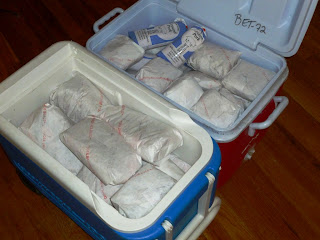Things are a bit slow down on the urban farm, so how about a brief story from Greg about holidays, travel, and an unloved little fish?
This year, as usual, the company for which I work shut down the entire facility for the week between Christmas and New Year's, and I took the opportunity to head back East to my native state of Illinois. I spent a wonderful weekend opening presents, eating a huge Polish dinner, going to my family's favorite coffee shop, and just hanging out with all of them. Then Tuesday came, and (almost) everybody had to go back to the real world, meaning back to work. So it was just my little sister and me, and we decided to go explore The City.
This trip was more novel for me, as my sister attends college in Chicago, and now probably almost feels at home there as much as she does in our suburban enclave. I however, wanted to see more of her campus, walk along the lakeshore, and eat at one very special restaurant.
That's
Uncommon Ground, a restaurant and bar specializing in local and sustainable foods, which was recently named the
Greenest restaurant in America. As a strong proponent of eating local and caring for the environment, I was excited to check it out.
One downside to visiting in December is that we couldn't look at possibly their coolest attribute: the certified organic rooftop garden from which much of their produce is grown. In my snapshot above, you can just see some of the raised beds and trellises which would be covered in green during the spring and summer months, but are sadly bare in late December. Even then, Uncommon Ground sources produce from nearby farms with greenhouses or high tunnels that can keep growing into the colder months. They also focus on seasonal produce, which means a lot more root vegetables this time of year.
There's a host of other neat green stuff about this place - recycled materials and furnishings everywhere, but I was more excited about the food! My sister ordered this flavorful flatbread, made with local gorgonzola cheese, and topped with small-farm bacon and pickled turnips!
And me? Well, I got that unloved fish I alluded to earlier. The Lake Whitefish, a small fish native to Lake Michigan, and part of a historic fishery now on the decline. By that, though, I don't mean that the whitefish is being overfished and that there aren't many left. It's actually the fishing of the whitefish that's starting to drop off.
You see, Lake Whitefish are small, and not particularly attractive, and as it became easier to ship in "exotic" fish like salmon and mahi mahi, people grew
less interested in this rather ordinary local option, so demand dropped.
That was their mistake, because Lake Whitefish make some amazing fish tacos! Uncommon Ground served them topped with some local greens and a unique sweet potato relish/salsa. Finished with a drizzle of a zesty pepper sauce, and served alongside house-made fries, it was one of the better meals I've ever eaten. The cold crisp beer from
Half Acre Beer Co, less than 5 miles away, was the perfect complement.
All in all, this was a dining experience I'll remember for a long time. The company was top-notch, the food was phenomenal, and I felt good about eating it, knowing that everything was responsibly sourced. I was able to fill my belly, all while supporting local small fishermen and farmers. The restaurant was still pretty busy as we had lunch around 2:00, which is a good sign for the local food movement. As this trend continues to gain steam, hopefully more restaurants will make room for these kinds of items on their menus. As they do, I know I'll continue to seek them out.














